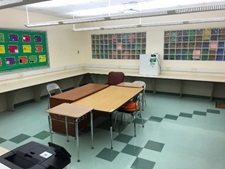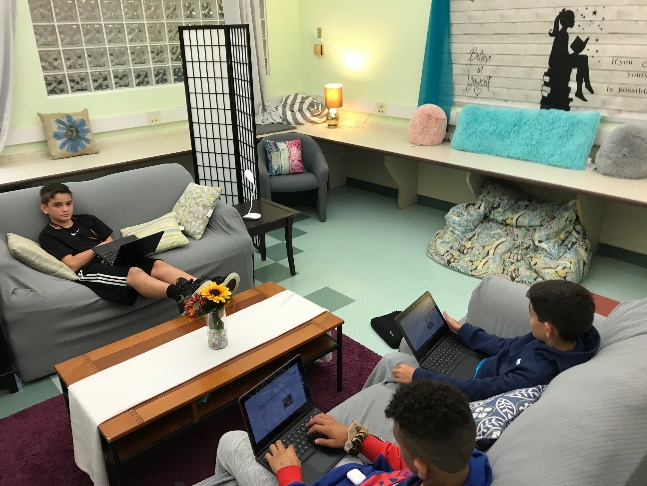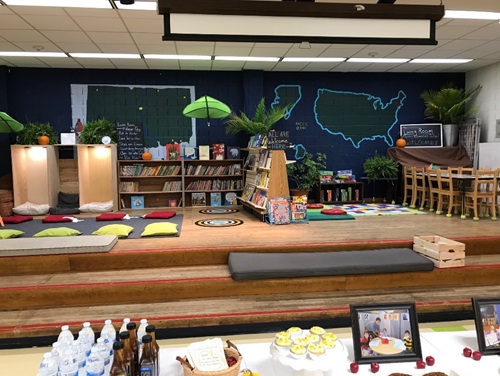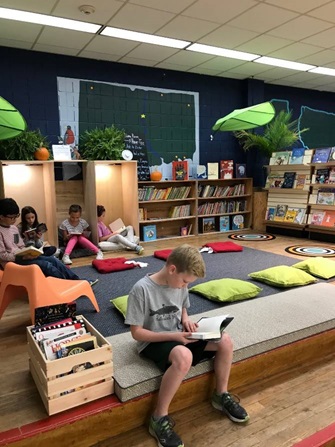A Tale of Two Living Rooms
Connecting Students and the Instructional Core
In my travels around the state visiting various districts, I was able to see the examples of student engagement and professional practices that allowed students to thrive including the use of “living rooms” as calm, safe spaces for students. Strangely enough, you can go years in the educational profession without encountering one example involving living rooms but, coincidentally, on the same October day, I had the good fortune to experience two examples centered around living rooms.
The first was my experience in Shelton Intermediate School. Here, students are randomly selected to participate in an Innovation Team called Unity of which the underlying principle is student voice. The pedagogy, design of units of study, and implementation of activities are centered around student voice and choice which I saw firsthand during my visit. Some students were preparing for a field trip by gathering background information on the sites they would visit. Other students, with teachers as facilitators, were collaborating to learn about additional historical concepts.
My guides on the Shelton visit were 13 year-old 8th graders who understood that innovation and choice are a big part of their experience this year, and will be for the rest of their lives.
They were eager to share about their experiences in their last project, a student contest involving the Unity Team on how to use the extra space in their learning pod. There was a classroom that had been used as a computer lab but was no longer needed for that purpose due to students having Chromebooks. The challenge, and project, for students was to innovatively plan and design a practical use for that space with their classmates. Students had to think about the need, the design, and the practical use the room could have for the students in the Unity Team. They also had to prepare a presentation to convince the teacher that their plan would be best for all students in Shelton Intermediate School.
 The winning entry was a “living room” of sorts based on a plan developed by students to use the space to independently work on assignments, study for a test, or complete work in a quiet and comfortable space. So what does a living room designed by 8th graders, for 8th graders, look like? A college campus; it was filled with couches, comfortable nooks for reading or completing assignments on Chromebooks, mood lamps, pillows, carpeting, and even walls painted in a color that was researched to be conducive for concentration. The only thing you would find on a college campus that was missing was a Starbucks, to which the students stated, “I wish”.
The winning entry was a “living room” of sorts based on a plan developed by students to use the space to independently work on assignments, study for a test, or complete work in a quiet and comfortable space. So what does a living room designed by 8th graders, for 8th graders, look like? A college campus; it was filled with couches, comfortable nooks for reading or completing assignments on Chromebooks, mood lamps, pillows, carpeting, and even walls painted in a color that was researched to be conducive for concentration. The only thing you would find on a college campus that was missing was a Starbucks, to which the students stated, “I wish”.
 To me this living room represented some of the best practices in public education in Connecticut. Students were allowed to use their agency to advocate for what they felt was best for learning, teachers facilitated this process by requiring a rigorous process to submit considerations for the room, and leaders encouraged and rewarded this process by allowing school space to be used in ways that students felt were best for learning.
To me this living room represented some of the best practices in public education in Connecticut. Students were allowed to use their agency to advocate for what they felt was best for learning, teachers facilitated this process by requiring a rigorous process to submit considerations for the room, and leaders encouraged and rewarded this process by allowing school space to be used in ways that students felt were best for learning.
The pride students took in sharing their living room with me and the process by which it came about was a great example of engagement, effective pedagogy, and rigorous curriculum connections that required academic skills to be applied in an authentic way. In that brief visit, I saw strong connections to the instructional core in a manner that not only made learning fun but a sense of community and unity among students.
Later that same afternoon, I headed to Redding Elementary School where I had the privilege of announcing the Connecticut’s 2020 Paraeducator of the Year Jamie Bairaktaris, who is affectionately known as Mr. B by the 500 students who are fortunate to know him. Among the many great things Mr. B does for the students of his school community (which only 12 years earlier he attended as a student) is the same reason the school leaders nominated him for this award— his work to facilitate the creation of The Living Room at Redding Elementary.
If you need a reminder why elementary paraeducators, teachers and school leaders deserve the utmost respect, or for anyone who has ever worked in an elementary school, visit a cafeteria in the middle of the day. The sounds of children laughing, talking, sometimes screaming, and chairs sliding along the floor, adults talking over the sound with microphones and screeching speakers, and the commands of adults trying to line up 75-100 hungry 6 year olds in a 20 minute period is an experience you will never forget!
 On this visit, after Mr. B received his award in from of 500 adoring and approving fans, he brought me to the cafeteria to see the Living Room. He converted space in the cafeteria to an oasis of books, games, reading couches, interactive games, and positive reinforcement. During lunch, students who had a desire to visit the Living Room had to show respect and appropriate cafeteria manners. When selected, they visited the Living Room, immersed themselves in a book, or engaged in a game with a friend. They enjoyed the rest of their lunch period with freedom, books, and a cozy pillow. How fortunate are they?!
On this visit, after Mr. B received his award in from of 500 adoring and approving fans, he brought me to the cafeteria to see the Living Room. He converted space in the cafeteria to an oasis of books, games, reading couches, interactive games, and positive reinforcement. During lunch, students who had a desire to visit the Living Room had to show respect and appropriate cafeteria manners. When selected, they visited the Living Room, immersed themselves in a book, or engaged in a game with a friend. They enjoyed the rest of their lunch period with freedom, books, and a cozy pillow. How fortunate are they?!
 Mr. B understood that if you convert students’ eating space into an area that they would want use then they would be more likely to demonstrate behaviors that would warrant a visit to the beloved Living Room. Mr. B also knew that students would take pride in this space and “self-regulate” the behaviors in this special area of the cafeteria. For students that struggled in larger or louder settings, this space provided a calming area. The students valued this space as much as they did the playground. In fact, when I visited, it was pristine, not because the custodian was told to tidy it up before the visitors arrived, but because a group of three 8 year-olds had taken ownership of making it a clean space for students. That sense of agency (the same that I noticed in Shelton) also exists in 8 year-olds in Redding. If you build it and empower students then they will take agency and care for it. Not only did this Living Room serve as a symbol of the community created within the Redding Elementary school cafeteria, to me it also represented the importance of every person on the school staff. For Paraeducator of the Year Mr. B, his impact was having a profound effect on all of the students in that school community.
Mr. B understood that if you convert students’ eating space into an area that they would want use then they would be more likely to demonstrate behaviors that would warrant a visit to the beloved Living Room. Mr. B also knew that students would take pride in this space and “self-regulate” the behaviors in this special area of the cafeteria. For students that struggled in larger or louder settings, this space provided a calming area. The students valued this space as much as they did the playground. In fact, when I visited, it was pristine, not because the custodian was told to tidy it up before the visitors arrived, but because a group of three 8 year-olds had taken ownership of making it a clean space for students. That sense of agency (the same that I noticed in Shelton) also exists in 8 year-olds in Redding. If you build it and empower students then they will take agency and care for it. Not only did this Living Room serve as a symbol of the community created within the Redding Elementary school cafeteria, to me it also represented the importance of every person on the school staff. For Paraeducator of the Year Mr. B, his impact was having a profound effect on all of the students in that school community.
The public schools of Connecticut serve as the living rooms of our communities. They are places to go, grow, and join together in community and, in my travels around the state on that October day, I was fortunate to witness two shining examples of that which I felt must be shared .
For more information on Innovative Practices using student voice, visit: Everyday Democracy. Information and tips on creating Calming Spaces in schools can be found at: Safe Schools NOLA.

